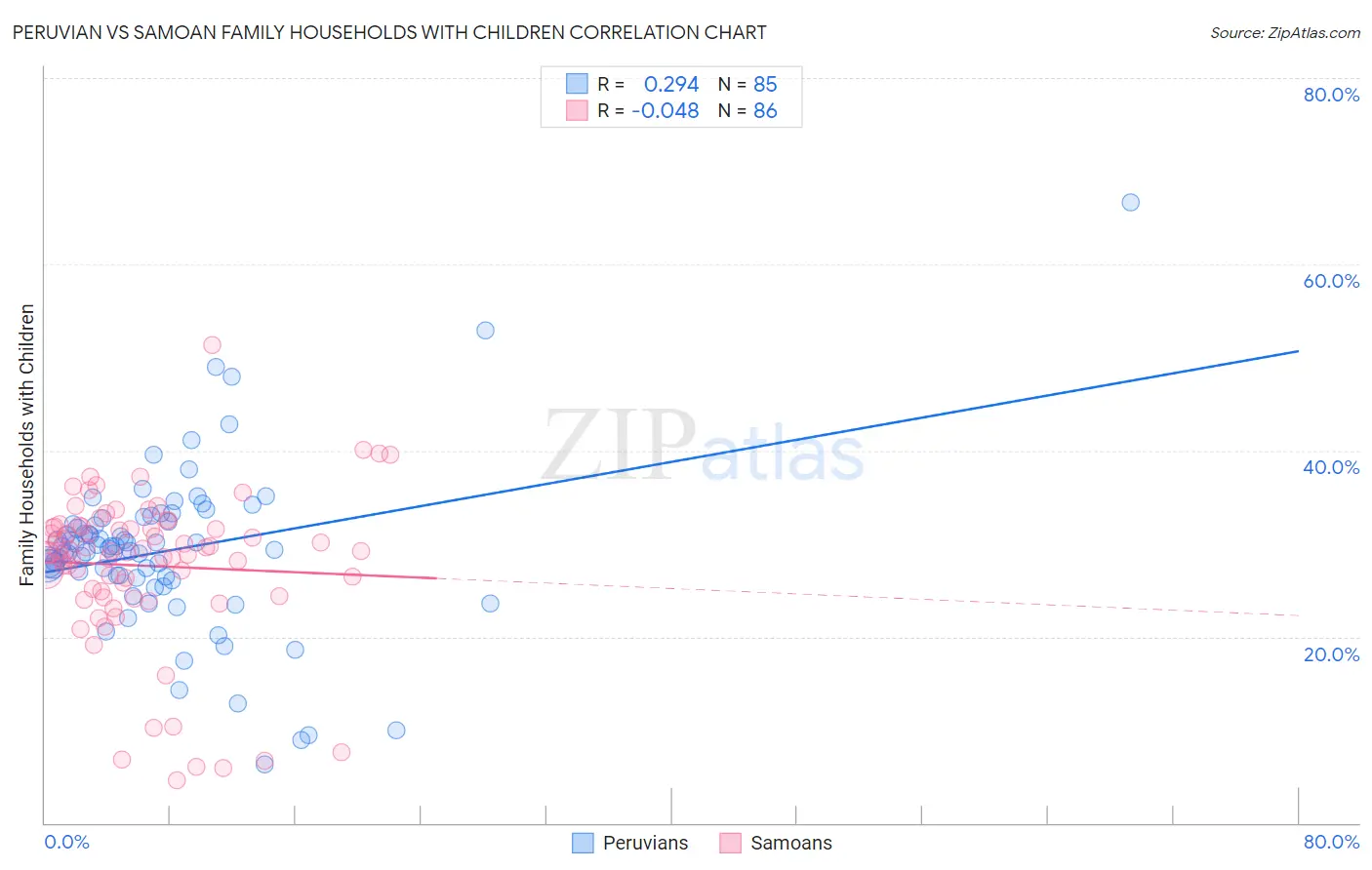Peruvian vs Samoan Family Households with Children
COMPARE
Peruvian
Samoan
Family Households with Children
Family Households with Children Comparison
Peruvians
Samoans
29.0%
FAMILY HOUSEHOLDS WITH CHILDREN
100.0/ 100
METRIC RATING
47th/ 347
METRIC RANK
29.5%
FAMILY HOUSEHOLDS WITH CHILDREN
100.0/ 100
METRIC RATING
28th/ 347
METRIC RANK
Peruvian vs Samoan Family Households with Children Correlation Chart
The statistical analysis conducted on geographies consisting of 362,805,667 people shows a weak positive correlation between the proportion of Peruvians and percentage of family households with children in the United States with a correlation coefficient (R) of 0.294 and weighted average of 29.0%. Similarly, the statistical analysis conducted on geographies consisting of 225,025,987 people shows no correlation between the proportion of Samoans and percentage of family households with children in the United States with a correlation coefficient (R) of -0.048 and weighted average of 29.5%, a difference of 1.7%.

Family Households with Children Correlation Summary
| Measurement | Peruvian | Samoan |
| Minimum | 6.2% | 4.6% |
| Maximum | 66.7% | 51.3% |
| Range | 60.4% | 46.7% |
| Mean | 29.2% | 27.6% |
| Median | 29.5% | 29.2% |
| Interquartile 25% (IQ1) | 26.3% | 24.8% |
| Interquartile 75% (IQ3) | 32.5% | 31.8% |
| Interquartile Range (IQR) | 6.2% | 6.9% |
| Standard Deviation (Sample) | 8.9% | 8.3% |
| Standard Deviation (Population) | 8.8% | 8.2% |
Demographics Similar to Peruvians and Samoans by Family Households with Children
In terms of family households with children, the demographic groups most similar to Peruvians are Immigrants from Philippines (29.0%, a difference of 0.010%), Fijian (29.0%, a difference of 0.090%), Immigrants from Taiwan (29.0%, a difference of 0.15%), Asian (29.1%, a difference of 0.19%), and Immigrants from South Eastern Asia (29.1%, a difference of 0.38%). Similarly, the demographic groups most similar to Samoans are Bolivian (29.5%, a difference of 0.0%), Yuman (29.5%, a difference of 0.040%), Immigrants from Vietnam (29.5%, a difference of 0.16%), Japanese (29.4%, a difference of 0.18%), and Immigrants from Yemen (29.4%, a difference of 0.24%).
| Demographics | Rating | Rank | Family Households with Children |
| Immigrants | Vietnam | 100.0 /100 | #27 | Exceptional 29.5% |
| Samoans | 100.0 /100 | #28 | Exceptional 29.5% |
| Bolivians | 100.0 /100 | #29 | Exceptional 29.5% |
| Yuman | 100.0 /100 | #30 | Exceptional 29.5% |
| Japanese | 100.0 /100 | #31 | Exceptional 29.4% |
| Immigrants | Yemen | 100.0 /100 | #32 | Exceptional 29.4% |
| Venezuelans | 100.0 /100 | #33 | Exceptional 29.4% |
| Immigrants | Bolivia | 100.0 /100 | #34 | Exceptional 29.3% |
| Immigrants | Sierra Leone | 100.0 /100 | #35 | Exceptional 29.3% |
| Immigrants | Venezuela | 100.0 /100 | #36 | Exceptional 29.3% |
| Immigrants | Cameroon | 100.0 /100 | #37 | Exceptional 29.2% |
| Koreans | 100.0 /100 | #38 | Exceptional 29.2% |
| Yaqui | 100.0 /100 | #39 | Exceptional 29.1% |
| Central Americans | 100.0 /100 | #40 | Exceptional 29.1% |
| Immigrants | South Eastern Asia | 100.0 /100 | #41 | Exceptional 29.1% |
| Spanish American Indians | 100.0 /100 | #42 | Exceptional 29.1% |
| Asians | 100.0 /100 | #43 | Exceptional 29.1% |
| Immigrants | Taiwan | 100.0 /100 | #44 | Exceptional 29.0% |
| Fijians | 100.0 /100 | #45 | Exceptional 29.0% |
| Immigrants | Philippines | 100.0 /100 | #46 | Exceptional 29.0% |
| Peruvians | 100.0 /100 | #47 | Exceptional 29.0% |